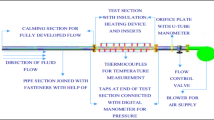Abstract
Heat transfer and friction factor characteristics in a circular tube fitted with core rod at high temperature have been investigated experimentally. In the experiments, ambient air with Reynolds numbers in a range of 9,000–26,000 is passed through a circular tube with uniform wall temperature and convection and radiation heat transfer phenomena are studied. Experiments have been performed on the tube with core rod insert considering four values of uniform wall temperature. For each wall temperature considered, convection and radiation heat transfer coefficients have been determined. The experimental results show that at uniform wall temperature of 373, 473, 553 and 633 K the average share of the radiation heat transfer coefficient to the total heat transfer coefficient is 10.7, 14.6, 20.5 and 22.3 % respectively. In addition it was noted that for the mentioned temperatures, the heat transfer coefficient increased by 234, 275, 304 and 334 % respectively when using tube containing the core insert in comparison to the plain tube. It was also noted that increasing the wall temperature also resulted in increase of friction factor.











Similar content being viewed by others
Abbreviations
- A:
-
Heat transfer surface area (m2)
- Cp,a:
-
Specific heat of air (J kg−1 K−1)
- \(D_{h}\) :
-
Hydraulic diameter (m)
- f :
-
Friction factor
- h:
-
Average heat transfer coefficient (W m−2 K−1)
- k:
-
Thermal conductivity (W m−1 K−1)
- L:
-
Length of test section (m)
- \(\dot{m}\) :
-
Mass flow rate (kg s−1)
- Nu:
-
Average Nusselt number
- Pr:
-
Prandtl number
- Q:
-
Heat transfer rate (W)
- R:
-
Resistance of the heater element (Ω)
- Re:
-
Reynolds number
- T:
-
Temperature (K)
- \(\tilde{T}\) :
-
Average temperature (K)
- u :
-
Mean axial velocity (m s−1)
- V:
-
Voltage output from the auto-transformer (V)
- \(V^{\prime }\) :
-
Volumetric flow rate (m3 s−1)
- \(\eta\) :
-
Enhancement efficiency
- \(\upsilon\) :
-
Kinematic viscosity (m2 s−1)
- \(\rho\) :
-
Density of the fluid (kg m−3)
- \(\varepsilon\) :
-
Wall emissivity
- \(\varDelta T_{\ln }\) :
-
Logarithmic mean temperature difference (K)
- ΔP:
-
Pressure drop (Pa)
- a:
-
Air
- b:
-
Bulk
- conv:
-
Convection
- cs:
-
Cross section area
- i:
-
Inlet
- loss:
-
Losses
- o:
-
Outlet
- p:
-
Plain tube
- pp:
-
Pumping power
- rad:
-
Radiation
- rod:
-
Rod
- s:
-
Side long area of heater
- t:
-
Turbulator
- tot:
-
Total
- vol:
-
Voltage
- w:
-
Wall
- \(\infty\) :
-
Atmospheric air
References
Marner WJ, Bergles AE, Chenoweth JM (1983) On the presentation of performance data for enhanced tubes used in shell-and tube heat exchangers. Trans ASME J Heat Transf 105:358–365
Bergles AE, Webb RL (1985) Guide to the literature on convection heat transfer augmentation. Adv Enhanc Heat Transf 43:81–89
Bergles AE (1985) Techniques to augment heat transfer. In: Rohsenow WM, Hartnett JP, Ganie E (eds) Handbook of heat transfer application. McGraw-Hill, New York
Promvonge P, Eiamsa-ard S (2006) Heat transfer enhancement in a tube with combined conical-nozzle inserts and swirl generator. Energy Convers Manag 47:2867–2882
Promvonge P, Eiamsa-ard S (2007) Heat transfer augmentation in a circular tube using V-nozzle turbulator inserts and snail entry. Exp Thermal Fluid Sci 32:332–340
Eiamsa-ard S, Promvonge P (2006) Experimental investigation of heat transfer and friction characteristics in a circular tube fitted with V-nozzle turbulators. Int Commun Heat Mass Transf 33:591–600
Sivashanmugam P, Suresh S (2007) Experimental studies on heat transfer and friction factor characteristics of turbulent flow through a circular tube with helical screw-tape inserts. Chem Eng Process 46:1292–1298
Sivashanmugam P, Suresh S (2006) Experimental studies on heat transfer and friction factor characteristics in laminar flow through a circular tube fitted with helical screw-tape inserts. J Appl Thermal Eng 26:1990–1997
Naphon P (2006) Heat transfer and pressure drop in the horizontal double pipes with and without twisted tape insert. Int Commun Heat Mass Transf 33:166–175
ASME (1984) Standard measurement of fluid flow in pipes using orifice, nozzle and venture. ASME MFC–3M–1984, 1–56, United Engineering Center, New York
Coleman HW, Steele WG (1989) Experimental and uncertainty analysis for engineers. Wiley, New York
ANSI/ASME (1986) Measurement uncertainty, PTC 19, 1–1985. Part I, 1986
Yakut K, Sahin B, Canbazoglu S (2004) Performance and flow-induced vibration characteristics for conical-ring turbulators. Appl Energy 79(1):65–76
Holman JP (1997) Heat transfer, 8th edn. McGraw-Hill, New York
Incropera FP, De Witt DP (1996) Fundamentals of heat and mass transfer, 3rd edn. Wiley, New Jersey
Author information
Authors and Affiliations
Corresponding author
Rights and permissions
About this article
Cite this article
Alijani, M.R., Hamidi, A.A. Convection and radiation heat transfer in a tube with core rod insert at high temperature. Heat Mass Transfer 51, 911–919 (2015). https://doi.org/10.1007/s00231-014-1459-1
Received:
Accepted:
Published:
Issue Date:
DOI: https://doi.org/10.1007/s00231-014-1459-1




